A Bibliometric Analysis and Visualization of Aviation Carbon Emissions Studies
Abstract
:1. Introduction
2. Methods and Data
2.1. Analysis Technology
2.2. Data Sources
2.3. Analysis Process
- (1)
- Parameter setting
- (a)
- Time split: The time span specifies the range of years in which the citations were published, and its value is determined by the distribution of citation years and the period of interest to the analyst. The length of the time partition is determined by dividing the entire time span into a number of years. It is recommended that equal time partitions are used, with independent filtering by threshold within the time partition.
- (b)
- Text processing: Terminology sources are derived from four subject domains: title, abstract, author keywords, and keyword+, where keyword+ is a keyword supplemented by Thomson Reuters based on the title of the reference and not listed by the author or publisher. Subject terms are classified as noun phrases and burst words. CiteSpace automatically extracts specific and explicit keywords as cluster tags to reflect research hotspots, and further extracts burst words from the cluster tags to reflect research frontier trends.
- (c)
- Node type: According to different analysis topics, corresponding node objects, such as authors and cited references, are selected for analysis. Please refer to other analysis topics in this paper for more information on node selection. The setting of the node type determines the type of object represented by the node in the diagram.
- (d)
- Selection criteria: CiteSpace controls the number of network nodes in a single time zone based on a threshold value, and citations that meet the threshold criteria are visualized. There are seven setting methods, such as g-index, Top N, Top N%, Threshold Interpolation, and Citation. Selection Citers first filter citations based on the TC field values in the citation records, and then set variable parameters as thresholds to filter references based on the selection method. For determining reasonable thresholds, iterations and comparisons can be made based on the number of citations, nodes, and connections selected in the Spatial Status and Process Reports data processing report in the lower left corner of the CiteSpace software interface.
- (e)
- Pruning: CiteSpace supports pathfinder and minimum spanning tree algorithms to control the number of connections in the network in order to reduce the density of connections and reduce crossover points. Note that increasing the clarity of the network does not change the number of nodes. The pathfinder algorithm keeps only the most important connections based on the triangle inequality. The principle of pruning the slicing network and pruning the merging network is to find and retain the earliest connections.
- (2)
- Knowledge graph customization
- (3)
- Knowledge mapping analysis
3. Results
3.1. Descriptive Analysis
3.1.1. An Examination of the Annual Publication Distribution
3.1.2. Analysis of Authors
3.1.3. Analysis of Journals
3.2. Co-Authorship Analysis
3.2.1. Co-Authorship Network
3.2.2. Network of Co-Authors’ Countries
3.3. Co-Citation Analysis
3.3.1. Analysis of Cited References
3.3.2. Analysis of Cited Journals
3.4. Keywords Co-Occurrence Analysis
4. Discussion
5. Conclusions
Author Contributions
Funding
Data Availability Statement
Conflicts of Interest
References
- Liu, J.; Tian, J.; Lyu, W.; Yu, Y. The impact of COVID-19 on reducing carbon emissions: From the angle of international student mobility. Appl. Energy 2022, 317, 119136. [Google Scholar] [CrossRef]
- ICAO. Climate Change Mitigation: CORSIA. In Introduction to CORSIA; ICAO: Montreal, QC, Canada, 2019; p. 208. [Google Scholar]
- Domingos, N.D.P. Fighting climate change in the air: Lessons from the EU directive on global aviation. Rev. Bras. De Política Int. 2012, 55, 70–87. [Google Scholar] [CrossRef] [Green Version]
- Scheelhaase, J.; Schaefer, M.; Grimme, W.; Maertens, S. Cost impacts of the inclusion of air transport into the European emissions trading scheme in the time period 2012–2020. Eur. J. Transp. Infrastruct. Res. 2012, 12, 2973. [Google Scholar]
- Gonçalves, V.K. The inclusion of aviation in the european union carbon emissions trading scheme. Ambiente Soc. 2013, 16, 83–98. [Google Scholar] [CrossRef] [Green Version]
- Abeyratne, R. Global market-based measures for aviation emissions. Environ. Policy Law 2015, 45, 102. [Google Scholar]
- Abeyratne, R. Progress Made on the Development of a Global Market-based Measure for Aircraft Emissions. Environ. Policy Law 2016, 46, 238. [Google Scholar]
- Petsonk, A.; Piris-Cabezas, P. Bridging the Allocation Gap in the ICAO MBM: A New Proposal. Carbon Clim. Law Rev. 2016, 10, 127–133. [Google Scholar]
- Lu, Y.; de Vries, W.T. A bibliometric and visual analysis of rural development research. Sustainability 2021, 13, 6136. [Google Scholar] [CrossRef]
- Zupic, I.; Čater, T. Bibliometric methods in management and organization. Organ. Res. Methods 2015, 18, 429–472. [Google Scholar] [CrossRef]
- Tian, X.; Geng, Y.; Zhong, S.; Wilson, J.; Gao, C.; Chen, W.; Hao, H. A bibliometric analysis on trends and characters of carbon emissions from transport sector. Transp. Res. Part D Transp. Environ. 2018, 59, 1–10. [Google Scholar] [CrossRef]
- Almulhim, A.I.; Bibri, S.E.; Sharifi, A.; Ahmad, S.; Almatar, K.M. Emerging trends and knowledge structures of urbanization and environmental sustainability: A regional perspective. Sustainability 2022, 14, 13195. [Google Scholar] [CrossRef]
- Barbu, L.; Mihaiu, D.M.; Șerban, R.A.; Opreana, A. Knowledge mapping of optimal taxation studies: A bibliometric analysis and network visualization. Sustainability 2022, 14, 1043. [Google Scholar] [CrossRef]
- Chen, C. Mapping Scientific Frontiers: The Quest for Knowledge Visualization; Springer Science & Business Media: Berlin, Germany, 2013. [Google Scholar]
- Chen, C. Information Visualization: Beyond the Horizon; Springer Science & Business Media: Berlin, Germany, 2004. [Google Scholar]
- Liang, C.; Luo, A.; Zhong, Z. Knowledge mapping of medication literacy study: A visualized analysis using CiteSpace. SAGE Open Med. 2018, 6, 2050312118800199. [Google Scholar] [CrossRef] [PubMed] [Green Version]
- Jing, G.; Wang, Y.; Guo, X.; Guo, S.; Jia, L. Analysis on the research status of the domestic aviation transformation and traffic safety in 2019. J. Saf. Environ. 2020, 20, 2024–2028. [Google Scholar]
- Yang, F.; Li, Z.; Ma, J.; Huang, T. Research hotspots and evolution of general aviation development: A visualization study based on knowledge mapping. J. Beijing Univ. Aeronaut. Astronaut. (Soc. Sci. Ed.) 2020, 33, 92–100. [Google Scholar]
- Shao, T.; Ye, Y. Research on cold-chain visualization based on knowledge mapping. Sci. Technol. Libr. 2020, 39, 307–323. [Google Scholar] [CrossRef]
- Sofik, S.; Rahman, Z. Global Visualization and Knowledge Mapping in the Field of Information Retrieval (IR): A Bibliometrics Analysis. Qual. Quant. Methods Libr. 2021, 10, 623–647. [Google Scholar]
- Mongeon, P.; Paul-Hus, A. The journal coverage of Web of Science and Scopus: A comparative analysis. Scientometrics 2016, 106, 213–228. [Google Scholar] [CrossRef]
- Sonnenwald, D.H. Scientific collaboration. Annu. Rev. Inf. Sci. Technol. 2007, 41, 643–681. [Google Scholar] [CrossRef]
- Romero-Izquierdo, A.G.; Gómez-Castro, F.I.; Gutiérrez-Antonio, C.; Hernández, S.; Errico, M. Intensification of the alcohol-to-jet process to produce renewable aviation fuel. Chem. Eng. Process. Process Intensif. 2021, 160, 108270. [Google Scholar] [CrossRef]
- Soria-Ornelas, M.L.; Gutiérrez-Antonio, C.; Gómez-Castro, F.I.; Hernández, S. Feasibility study of using reactive distillation for the production of renewable aviation fuel. Comput. Aided Chem. Eng. 2018, 43, 639–644. [Google Scholar]
- Domínguez-García, S.; Gutiérrez-Antonio, C.; De Lira-Flores, J.A.; Ponce-Ortega, J.M.; El-Halwagi, M.M. Strategic planning for the supply chain of aviation biofuel with consideration of hydrogen production. Ind. Eng. Chem. Res. 2017, 56, 13812–13830. [Google Scholar] [CrossRef]
- Moreno-Gómez, A.L.; Gutiérrez-Antonio, C.; Gómez-Castro, F.I.; Hernández, S. Modelling, simulation and intensification of the hydroprocessing of chicken fat to produce renewable aviation fuel. Chem. Eng. Process. Process Intensif. 2021, 159, 108250. [Google Scholar] [CrossRef]
- Gutiérrez-Antonio, C.; Romero-Izquierdo, A.G.; Gómez-Castro, F.I.; Hernández, S.; Briones-Ramírez, A. Simultaneous energy integration and intensification of the hydrotreating process to produce biojet fuel from Jatropha curcas. Chem. Eng. Process. Process Intensif. 2016, 110, 134–145. [Google Scholar] [CrossRef]
- Domínguez-García, S.; Gutiérrez-Antonio, C.; Lira-Flores, D.; Armando, J.; Ponce-Ortega, J.M. Optimal planning for the supply chain of biofuels for aviation in Mexico. Clean Technol. Environ. Policy 2017, 19, 1387–1402. [Google Scholar] [CrossRef]
- Gutiérrez-Antonio, C.; Gómez-Castro, F.I.; Romero-Izquierdo, A.G.; Hernández, S. Energy integration of a hydrotreating process for the production of biojet fuel. Comput. Aided Chem. Eng. 2016, 38, 127–132. [Google Scholar]
- Gutiérrez-Antonio, C.; Gómez-Castro, F.I.; de Lira-Flores, J.A.; Hernández, S. A review on the production processes of renewable jet fuel. Renew. Sustain. Energy Rev. 2017, 79, 709–729. [Google Scholar] [CrossRef]
- Gutiérrez-Antonio, C.; Romero-Izquierdo, A.G.; Israel Gómez-Castro, F.; Hernández, S. Energy integration of a hydrotreatment process for sustainable biojet fuel production. Ind. Eng. Chem. Res. 2016, 55, 8165–8175. [Google Scholar] [CrossRef]
- Gutiérrez-Antonioa, C.; Gómez-Castrob, F.I.; Hernándezb, S. Sustainable production of renewable aviation fuel through intensification strategies. Chem. Eng. 2018, 69, 319–324. [Google Scholar] [CrossRef]
- Gutiérrez-Antonio, C.; Romero-Izquierdo, A.G.; Gómez-Castro, F.I.; Hernández, S. Modeling, simulation and intensification of hydroprocessing of micro-algae oil to produce renewable aviation fuel. Clean Technol. Environ. Policy 2018, 20, 1589–1598. [Google Scholar] [CrossRef]
- Chen, N.; Sridhar, B.; Li, J.; Ng, H. Evaluation of Contrail Reduction Strategies Based on Aircraft Flight Distances. In Proceedings of the AIAA Guidance, Navigation, and Control Conference, Minneapolis, MN, USA, 13–16 August 2012. [Google Scholar]
- Sridhar, B.; Ng, H.; Chen, N. Integration of linear dynamic emission and climate models with air traffic simulations. In Proceedings of the AIAA Guidance, Navigation, and Control Conference, Minneapolis, MN, USA, 13–16 August 2012. [Google Scholar]
- Sridhar, B.; Chen, N.Y.; Ng, H. Aircraft Trajectory Design Based on Reducing the Combined Effects of Carbon-Di-Oxide, Oxides of Nitrogen and Contrails. In Proceedings of the AIAA Modeling and Simulation Technologies Conference, Atlanta, GA, USA, 16–20 June 2014. [Google Scholar]
- Sridhar, B.; Chen, N.; Ng, H.; Morando, A. Modeling and simulation of the impact of air traffic operations on the environment. In Proceedings of the AIAA Modeling and Simulation Technologies Conference, Portland, OR, USA, 8–11 August 2011. [Google Scholar]
- Ng, H.K.; Sridhar, B.; Grabbe, S.; Chen, N. Cross-polar aircraft trajectory optimization and the potential climate impact. In Proceedings of the 2011 IEEE/AIAA 30th Digital Avionics Systems Conference, Seattle, WA, USA, 16–20 October 2011. [Google Scholar]
- Chen, N.Y.; Kirschen, P.; Sridhar, B.; Ng, H.K. Identification of flights for cost-efficient climate impact reduction. In Proceedings of the AIAA/3AF Aircraft Noise and Emissions Reduction Symposium, Atlanta, GA, USA, 16–20 June 2014. [Google Scholar]
- Chen, N.Y.; Sridhar, B.; Ng, H.; Li, J. Evaluating tradeoff between environmental impact and operational costs for enroute air traffic. In Proceedings of the AIAA Guidance, Navigation, and Control Conference, National Harbor, MD, USA, 13–17 January 2014. [Google Scholar]
- Lee, D.; Pitari, G.; Grewe, V.; Gierens, K.; Penner, J.; Petzold, A.; Prather, M.; Schumann, U.; Bais, A.; Berntsen, T. Transport impacts on atmosphere and climate: Aviation. Atmos. Environ. 2010, 44, 4678–4734. [Google Scholar] [CrossRef] [PubMed] [Green Version]
- Moore, R.H.; Thornhill, K.L.; Weinzierl, B.; Sauer, D.; D’Ascoli, E.; Kim, J.; Lichtenstern, M.; Scheibe, M.; Beaton, B.; Beyersdorf, A.J.; et al. Biofuel blending reduces particle emissions from aircraft engines at cruise conditions. Nature 2017, 543, 411–415. [Google Scholar] [CrossRef] [Green Version]
- Peeters, P.; Higham, J.; Kutzner, D.; Cohen, S.; Gössling, S. Are technology myths stalling aviation climate policy? Transp. Res. Part D Transp. Environ. 2016, 44, 30–42. [Google Scholar] [CrossRef] [Green Version]
- Staples, M.D.; Malina, R.; Suresh, P.; Hileman, J.I.; Barrett, S.R. Aviation CO2 emissions reductions from the use of alternative jet fuels. Energy Policy. 2018, 114, 342–354. [Google Scholar] [CrossRef]
- Kousoulidou, M.; Lonza, L. Biofuels in aviation: Fuel demand and CO2 emissions evolution in Europe toward 2030. Transp. Res. Part D Transp. Environ. 2016, 46, 166–181. [Google Scholar] [CrossRef]
- Lee, D.S.; Fahey, D.W.; Forster, P.M.; Newton, P.J.; Wit, R.C.; Lim, L.L.; Owen, B.; Sausen, R. Aviation and global climate change in the 21st century. Atmos. Environ. 2009, 43, 3520–3537. [Google Scholar] [CrossRef] [PubMed] [Green Version]
- Becken, S.; Mackey, B. What role for offsetting aviation greenhouse gas emissions in a deep-cut carbon world? J. Air Transp. Manag. 2017, 63, 71–83. [Google Scholar] [CrossRef]
- Sgouridis, S.; Bonnefoy, P.A.; Hansman, R.J. Air transportation in a carbon constrained world: Long-term dynamics of policies and strategies for mitigating the carbon footprint of commercial aviation. Transp. Res. Part A Policy Pract. 2011, 45, 1077–1091. [Google Scholar] [CrossRef]
- Owen, B.; Lee, D.S.; Lim, L. Flying into the future: Aviation emissions scenarios to 2050. Environ. Sci. Technol. 2010, 44, 2255–2260. [Google Scholar] [CrossRef]
- Fuglestvedt, J.S.; Shine, K.P.; Berntsen, T.; Cook, J.; Lee, D.S.; Stenke, A.; Skeie, R.B.; Velders, G.J.M.; Waitz, I.A. Transport impacts on atmosphere and climate: Metrics. Atmos. Environ. 2010, 44, 4648–4677. [Google Scholar] [CrossRef] [Green Version]
- Chen, C. CiteSpace II: Detecting and visualizing emerging trends and transient patterns in scientific literature. J. Am. Soc. Inf. Sci. Technol. 2006, 57, 359–377. [Google Scholar] [CrossRef] [Green Version]
- Bows, A.; Anderson, K.L. Policy clash: Can projected aviation growth be reconciled with the UK Government’s 60% carbon-reduction target? Transp. Policy 2007, 14, 103–110. [Google Scholar] [CrossRef]
- Cairns, S.; Newson, C.; Boardman, B.; Anable, J. Predict and Decide: Aviation, Climate Change and UK Policy; Environmental Change Institute, University of Oxford: Oxford, UK, 2006. [Google Scholar]
- Grewe, V.; Stenke, A. AirClim: An efficient tool for climate evaluation of aircraft technology. Atmos. Chem. Phys. 2008, 8, 4621–4639. [Google Scholar] [CrossRef] [Green Version]
- Wilkerson, J.T.; Jacobson, M.Z.; Malwitz, A.; Balasubramanian, S.; Wayson, R.; Fleming, G.; Naiman, A.D.; Lele, S.K. Analysis of emission data from global commercial aviation: 2004 and 2006. Atmos. Chem. Phys. 2010, 10, 6391–6408. [Google Scholar] [CrossRef] [Green Version]
- Chiaramonti, D.; Prussi, M.; Buffi, M.; Tacconi, D. Sustainable bio kerosene: Process routes and industrial demonstration activities in aviation biofuels. Appl. Energy 2014, 136, 767–774. [Google Scholar] [CrossRef]
- Gao, F.; Jia, X.; Zhao, Z.; Chen, C.C.; Xu, F.; Geng, Z.; Song, X. Bibliometric analysis on tendency and topics of artificial intelligence over last decade. Microsyst. Technol. 2021, 27, 1545–1557. [Google Scholar] [CrossRef]
- Koroneos, C.; Dompros, A.; Roumbas, G.; Moussiopoulos, N. Advantages of the use of hydrogen fuel as compared to kerosene. Resour. Conserv. Recycl. 2005, 44, 99–113. [Google Scholar] [CrossRef]
- Cabrera, E.; de Sousa, J.M.M. Use of Sustainable Fuels in Aviation—A Review. Energies 2022, 15, 2440. [Google Scholar] [CrossRef]

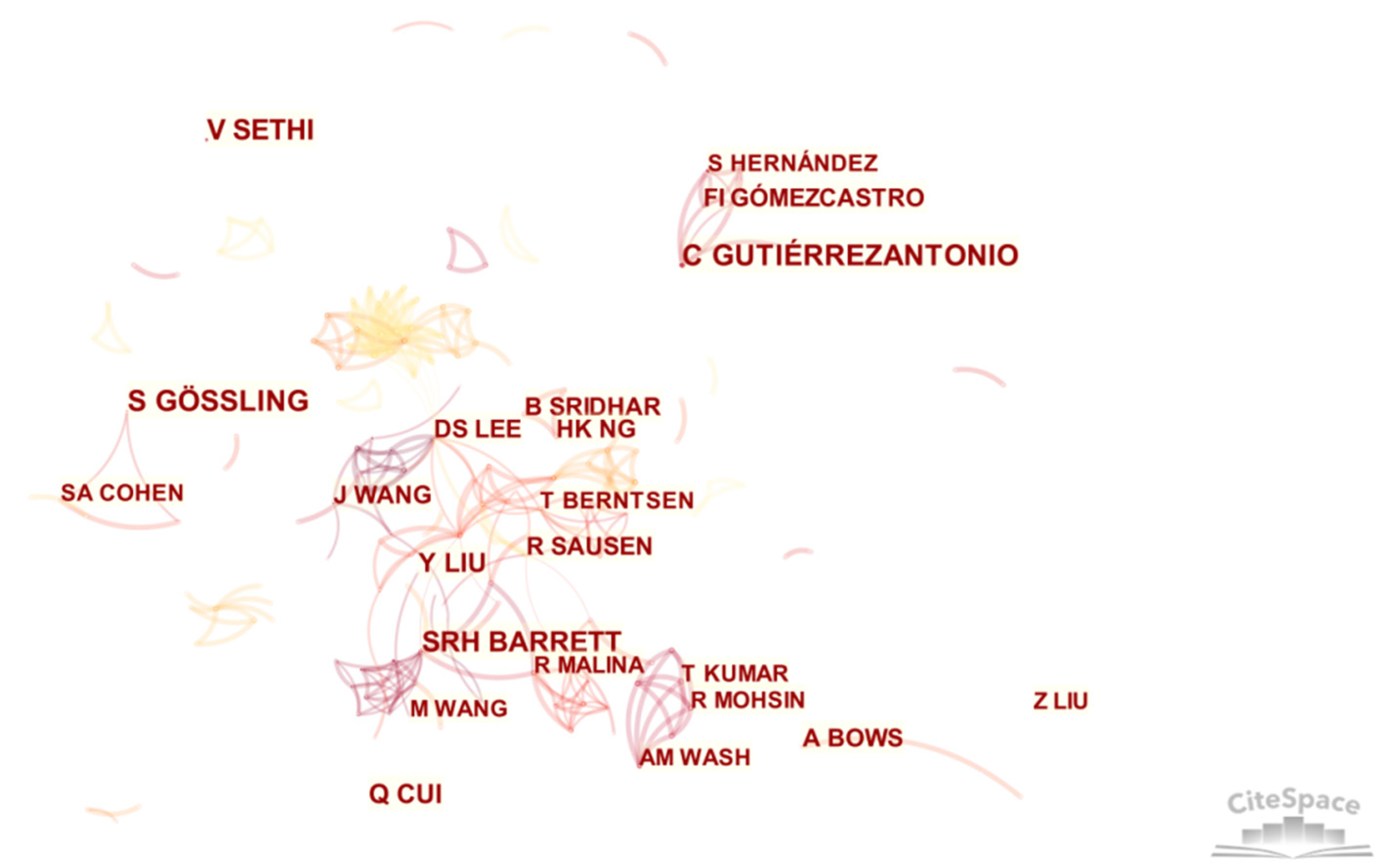

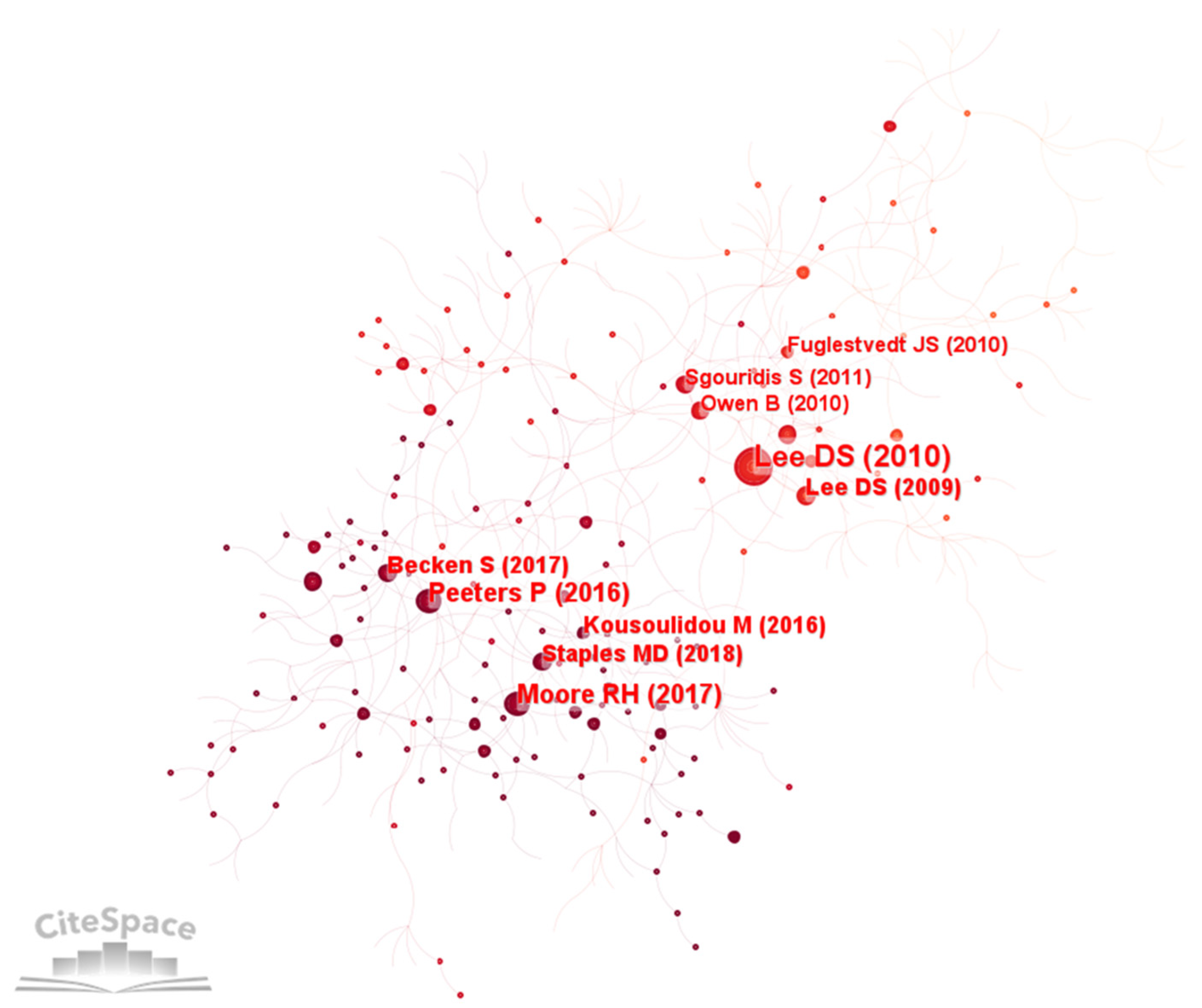
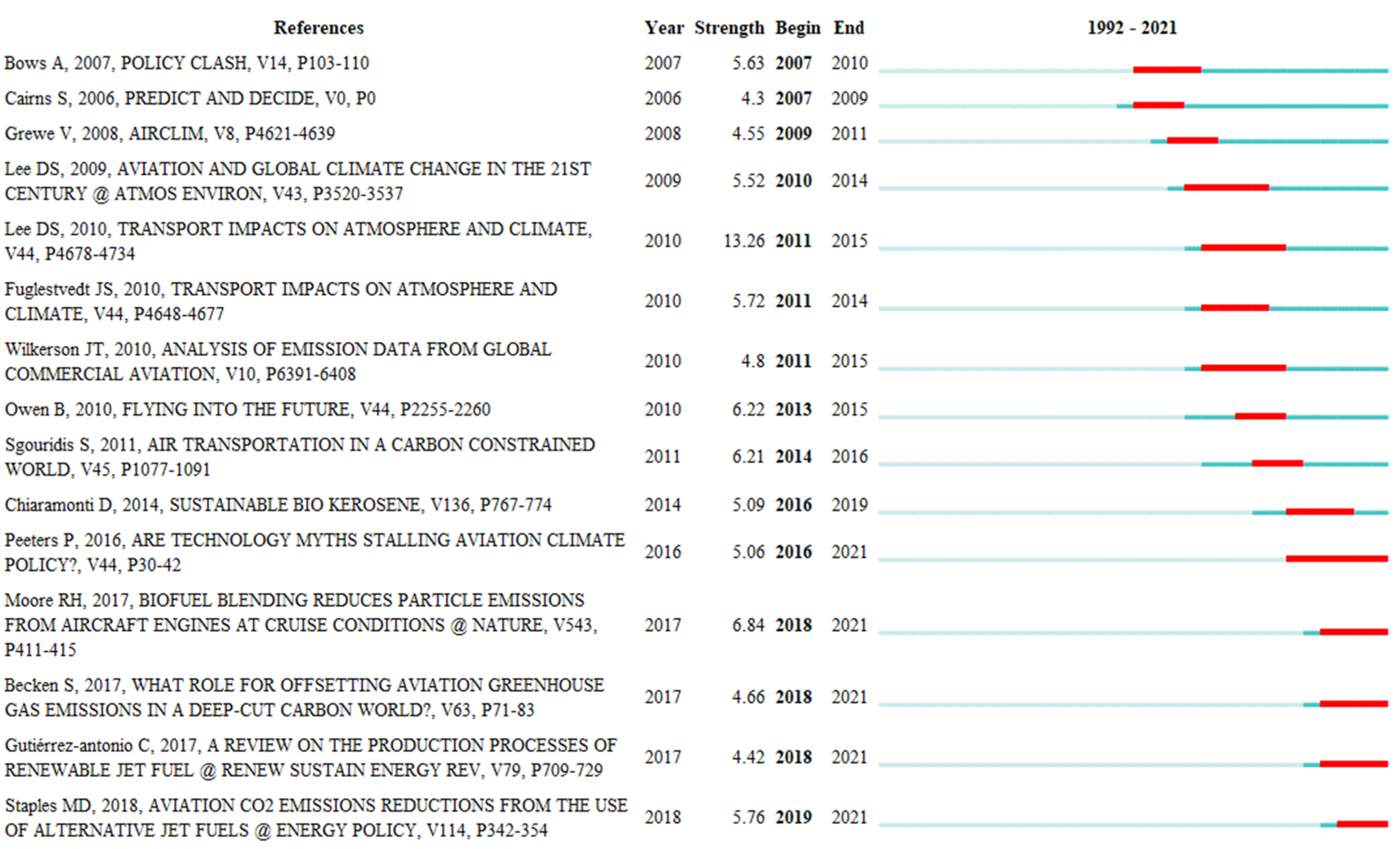
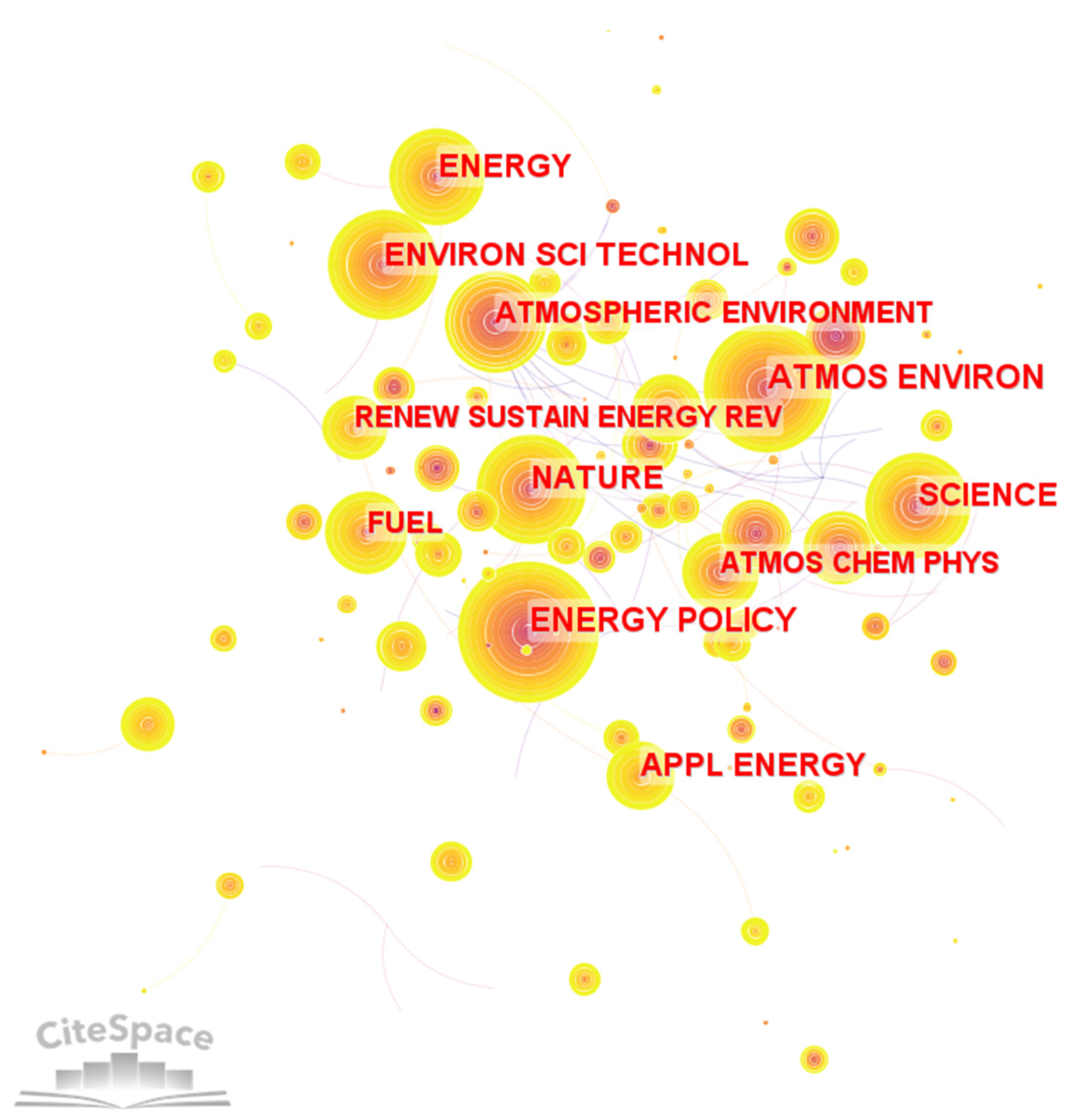


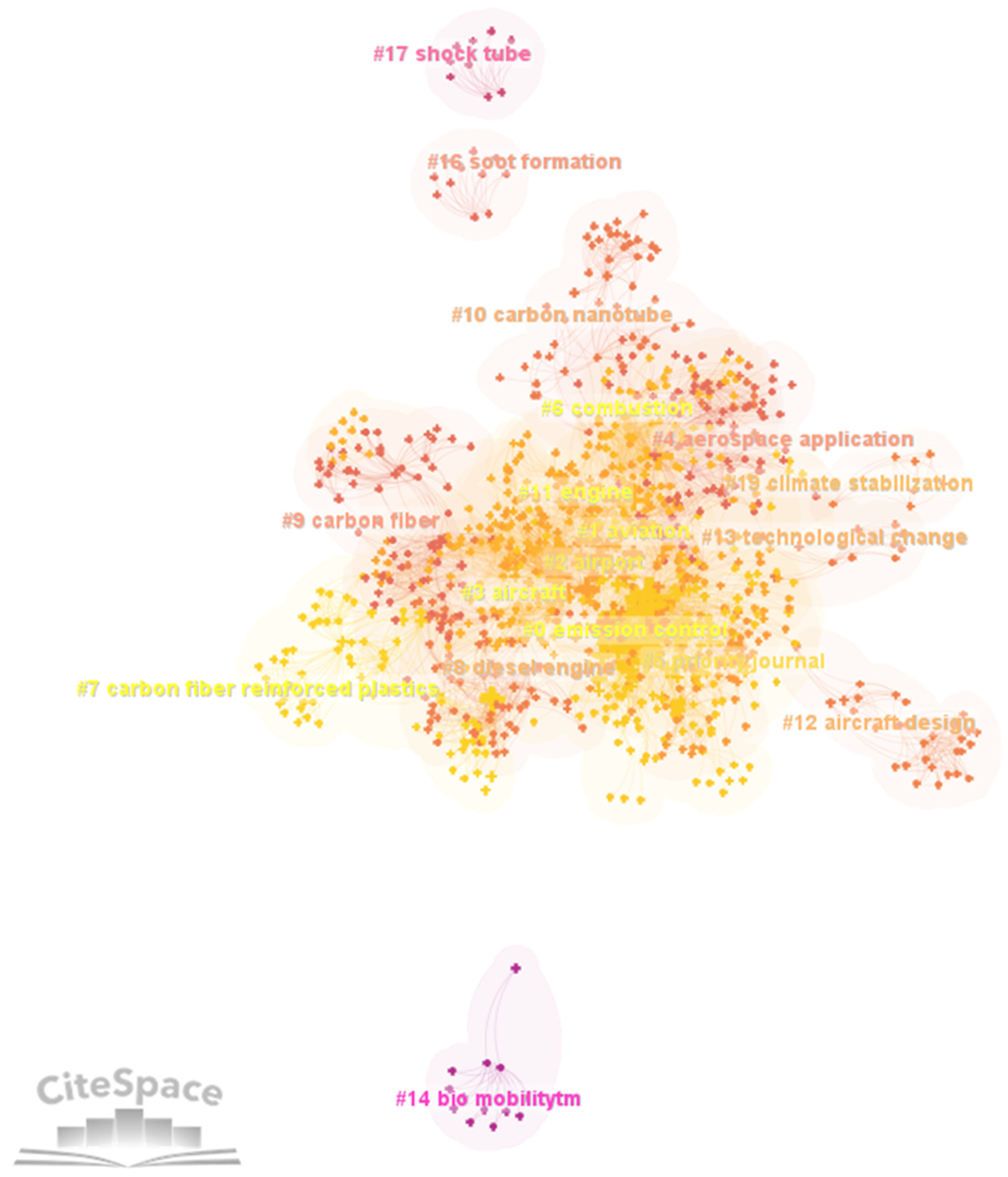
| Rank | Authors | Institution | Pubs | H-Index | Cites | Main Focuses |
|---|---|---|---|---|---|---|
| 1 | Gössling, S. | Lund University | 17 | 84 | 29,008 | Transport, Tourism, Sustainability |
| 2 | Lee, D.S. | Manchester Metropolitan University | 15 | 31 | 6674 | Climate impact of aviation |
| 3 | Barrett, S.R.H. | Massachusetts Institute of Technology | 14 | 45 | 6341 | Sustainable aviation |
| 4 | Sausen, R. | Deutsches Zentrum für Luft-und Raumfahrt | 14 | 47 | 7635 | Climate impact of aviation |
| 5 | Grewe, V. | Deutsches Zentrum für Luft-und Raumfahrt | 13 | 45 | 7783 | Climate impact of aviation |
| 6 | Sethi, V. | Cranfield University | 13 | 13 | 725 | Aviation Design |
| 7 | GutiérrezAntonio, C. | Universidad Autónoma de Querétaro | 12 | 17 | 1262 | Biojet fuel |
| 8 | Lim, L.L. | Manchester Metropolitan University | 11 | 10 | 1268 | Climate impact of aviation |
| 9 | Miake-Lye, R.C. | Aerodyne Research Inc. | 11 | 34 | 2189 | Aviation Design |
| 10 | Ng, H.K. | University of California | 11 | 14 | 410 | Aviation Systems |
| Rank | Journals | Pubs | Category | IF | Quartile |
|---|---|---|---|---|---|
| 1 | Transportation Research Part D Transport and Environment | 46 | SCIE, SSCI | 7.041 | Q1 |
| 2 | Critical Reviews in Environmental Science and Technology | 35 | SCIE | 11.750 | Q1 |
| 3 | Atmospheric Environment | 33 | SCIE | 5.755 | Q1 |
| 4 | Energy Policy | 32 | SCIE, SSCI | 7.576 | Q1 |
| 5 | Journal Of Air Transport Management | 30 | SSCI | 5.428 | Q2 |
| 6 | Journal of Cleaner Production | 28 | SCIE | 11.072 | Q1 |
| 7 | Sustainability | 23 | SCIE, SSCI | 3.889 | Q2 |
| 8 | Atmospheric Chemistry and Physics | 21 | SCIE | 7.197 | Q1 |
| 9 | Energies | 20 | SCIE | 3.252 | Q3 |
| 10 | Applied Energy | 18 | SCIE | 11.446 | Q1 |
| Rank | Journals | Frequency | Burst |
|---|---|---|---|
| 1 | Atmospheric Environment | 325 | 14.8422 |
| 2 | Energy Policy | 206 | 9.1187 |
| 3 | Environmental Science & Technology | 181 | - |
| 4 | Energies | 172 | 5.9381 |
| 5 | Nature | 164 | - |
| 6 | Science | 143 | - |
| 7 | Applied Energy | 136 | 5.7581 |
| 8 | Fuel | 133 | - |
| 9 | Atmospheric Chemistry and physics | 107 | - |
| 10 | Renewable and Sustainable Energy Reviews | 97 | - |
Disclaimer/Publisher’s Note: The statements, opinions and data contained in all publications are solely those of the individual author(s) and contributor(s) and not of MDPI and/or the editor(s). MDPI and/or the editor(s) disclaim responsibility for any injury to people or property resulting from any ideas, methods, instructions or products referred to in the content. |
© 2023 by the authors. Licensee MDPI, Basel, Switzerland. This article is an open access article distributed under the terms and conditions of the Creative Commons Attribution (CC BY) license (https://creativecommons.org/licenses/by/4.0/).
Share and Cite
Li, X.; Tang, J.; Li, W.; Si, Q.; Guo, X.; Niu, L. A Bibliometric Analysis and Visualization of Aviation Carbon Emissions Studies. Sustainability 2023, 15, 4644. https://doi.org/10.3390/su15054644
Li X, Tang J, Li W, Si Q, Guo X, Niu L. A Bibliometric Analysis and Visualization of Aviation Carbon Emissions Studies. Sustainability. 2023; 15(5):4644. https://doi.org/10.3390/su15054644
Chicago/Turabian StyleLi, Xirui, Junqi Tang, Weidong Li, Qingmin Si, Xinyao Guo, and Linqing Niu. 2023. "A Bibliometric Analysis and Visualization of Aviation Carbon Emissions Studies" Sustainability 15, no. 5: 4644. https://doi.org/10.3390/su15054644





